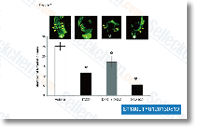New disease marker genes and potential drug targets were revealed. Shared ailment mechanisms, although hypothe tical on the current, were proposed based on frequent marker genes and interconnecting PPIs to clarify the shared symptoms amongst ailments. A core functional module of BA10 was also proposed. Illness markers and potential drug targets The genes which had P values 0. 01 in our t exams were defined as abnormally expressed in disorder samples. These genes have been proposed as illness marker genes and con structed right into a PPI network as illustrated in Figure 2. Former scientific studies have shown that the probes with lower P values appeared as more successful clustering functions for separat ing the disorder samples in the controls in hierarchical clusters. The observation advised that genes with decrease P values are additional vital dis ease markers. The genes with the lowest P values in our t tests weren’t properly studied genes.
SBNO2 was a gene of which the probe had the lowest P worth in the t test evaluating schi zophrenia and selleckchem management samples. SBNO2 has a strawberry notch homolog in fruit fly. The gene is concerned in the anti inflammatory signalling pathway. It’s also been connected with kind two diabetes mellitus, of which shared a lot of condition genes with psychological illnesses. SEC24C was a gene of which the probe had the lowest P value within the t check comparing bipolar disorder and control samples. SEC24C encodes a protein which could be involved in ER to Golgi vesicular transportation. It’s been asso ciated yet another psychological disease, Alzheimers disease. SRRT was a gene of which the probe had the lowest P worth inside the t test evaluating main depression and manage samples. SRRT is potentially concerned in transcriptional regu lation and RNA metabolism because it is really a homolog to an Arabidopsis serrate RNA effector.
Apart from this examine, SBNO2, SEC24C and SRRT have never been asso ciated with schizophrenia, bipolar disorder, or important depression. these genes didn’t form PPI with any of our abnormally expressed Motesanib marker genes, both.  There appeared a weak unfavorable correlation in between the P values of the gene and its centrality ranks in this examine. A lot more necessary proteins in PPI networks have also been proven to rank higher than much less impor tant proteins in centrality analyses. Interestingly, the nodes which ranked highest in the centrality scientific studies have been mostly schizophrenia markers as listed in Table 3. The prime ranked genes in centrality analysis, UBC, ACTB, and UBB, have been all abnormally expressed in schi zophrenia samples. UBC and UBB encode the polyubi quitin precursors. ACTB encodes the beta actin protein. The roles of these proteins in mental condition mechan isms are usually not clear. None of those 3 genes are actually associated with any mental disease. but UBC is linked also with form two diabetes mellitus.
There appeared a weak unfavorable correlation in between the P values of the gene and its centrality ranks in this examine. A lot more necessary proteins in PPI networks have also been proven to rank higher than much less impor tant proteins in centrality analyses. Interestingly, the nodes which ranked highest in the centrality scientific studies have been mostly schizophrenia markers as listed in Table 3. The prime ranked genes in centrality analysis, UBC, ACTB, and UBB, have been all abnormally expressed in schi zophrenia samples. UBC and UBB encode the polyubi quitin precursors. ACTB encodes the beta actin protein. The roles of these proteins in mental condition mechan isms are usually not clear. None of those 3 genes are actually associated with any mental disease. but UBC is linked also with form two diabetes mellitus.
Mirna Array
Fast, easy and accurate miRNA profiling using mirna array
